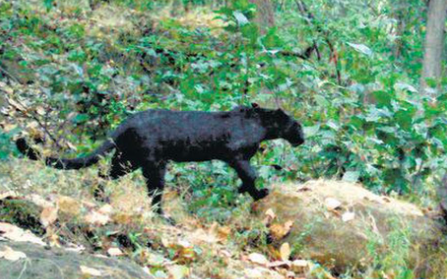Odisha Records Rare Black Panther Sightings in Forests
Odisha’s forest officials conducted the “All Odisha Leopard Estimation,” which revealed the presence of rare melanistic leopards, commonly known as black panthers, in three different forest areas. This survey covered 47 forest divisions across the state.
What is a Melanistic Leopard?
A melanistic leopard is a leopard with a genetic mutation that causes its fur to appear black due to an excess of melanin. Despite their dark coat, the typical leopard rosette patterns are still visible in certain lighting conditions. These black panthers are not a different species but are simply a color variant of regular leopards. They have better camouflage in dense forests, which helps them survive in those environments. However, they are very rare, making up only about 11% of the leopard population in certain regions, such as Africa and Asia.
Current Leopard Population
The discovery of melanistic leopards is significant because these rare animals face unique conservation challenges. Their locations are kept secret to prevent poaching, which is a major threat to their survival. The presence of these black panthers highlights the need for focused efforts to protect them.
Current Leopard Population in Odisha
The latest survey found that Odisha is home to 696 leopards, which is an increase of 128 from the previous count. However, this number is still lower than the 760 leopards reported by the National Tiger Conservation Authority (NTCA) in 2018.
How was the Leopard Population Estimated?
Odisha’s forest department used a detailed approach to count the leopards. They looked for signs like paw prints (pugmarks), droppings (scats), and the sounds leopards make (vocalizations). They also set up camera traps to capture images of the animals. The NTCA’s 2018 survey, on the other hand, relied more on statistical models and fewer camera traps, which led to a higher margin of error in their estimates.
Comparison of Results
The NTCA’s survey in 2018 had an error margin of 35%, meaning their estimate could have been off by quite a bit. In contrast, Odisha’s more thorough method produced a much lower error margin of less than 10%, making their count more reliable.
Key Habitats for Leopards in Odisha
The Similipal Tiger Reserve remains the most important habitat for leopards and Royal Bengal Tigers in Odisha. The Satkosia landscape also showed a growing population of leopards, ranking second in terms of leopard numbers in the state.
Although the number of leopards in Odisha is increasing, poaching remains a serious problem. Between 2018 and 2023, 59 leopard skins were seized in the state, showing that illegal hunting still threatens these animals. Continuous conservation efforts are needed to protect them and ensure their population continues to grow.
Month: Current Affairs - October, 2024
Category: States Current Affairs








